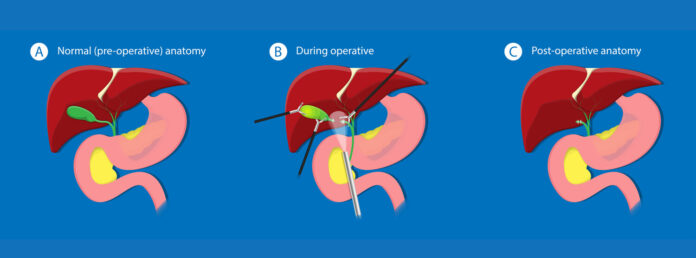What is a Cholecystectomy?
A cholecystectomy is a surgical procedure to remove the gallbladder, a small pear-shaped organ located beneath the liver. The gallbladder stores and concentrates bile—a digestive fluid produced by the liver—before releasing it into the small intestine to help digest fats.
This surgery is commonly performed to treat gallstones and the complications they cause, including pain, infection, and inflammation.
Why is a Cholecystectomy Performed?
The most common reasons for a cholecystectomy include:
- Gallstones (cholelithiasis) causing pain or discomfort
- Gallbladder inflammation (cholecystitis)
- Pancreatitis caused by gallstones blocking bile flow
- Gallbladder polyps or suspected gallbladder cancer (less common)
Symptoms that might lead to surgery include:
- Severe upper abdominal pain
- Nausea and vomiting
- Fever or signs of infection
- Jaundice (yellowing of the skin or eyes)
Types of Cholecystectomy
There are two primary surgical approaches:
1. Laparoscopic Cholecystectomy
- The most common method.
- Minimally invasive: involves 3–4 small incisions.
- A tiny camera (laparoscope) guides the surgeon.
- Shorter recovery time and less pain.
2. Open Cholecystectomy
- Performed through a larger incision in the upper right abdomen.
- Used when laparoscopy is not feasible (e.g., severe infection, scarring, or complications).
- Longer hospital stay and recovery period.

The Procedure
The surgery is typically done under general anesthesia. During a laparoscopic cholecystectomy:
- The abdomen is inflated with gas for better visibility.
- The surgeon removes the gallbladder using special instruments.
- The incisions are closed with sutures or surgical glue.
The whole procedure usually takes around 1 hours.
Risks and Complications
Cholecystectomy is generally safe, but like any surgery, it carries potential risks:
- Infection or bleeding
- Bile duct injury
- Bile leakage into the abdomen
- Blood clots
- Reactions to anesthesia
Long-term, some patients may experience diarrhea or changes in digestion, known as post-cholecystectomy syndrome, but these symptoms are often temporary or manageable.
Recovery and Aftercare
After Laparoscopic Surgery:
- Discharged within 24 hours
- Return to normal activities in 1–2 weeks
- Light diet initially, progressing as tolerated
Laparoscopic cholecystectomy is a safe, effective, and minimally invasive procedure for treating gallbladder disease. With proper preoperative assessment and skilled surgical technique, the majority of patients experience rapid recovery and lasting relief from symptoms.
After Open Surgery:
- Hospital stay of 3–5 days
- Full recovery may take 4–6 weeks
Patients are advised to:
- Avoid heavy lifting for several weeks
- Eat a low-fat diet initially
- Monitor for signs of infection (fever, swelling, redness)
Life Without a Gallbladder
Most people live a normal, healthy life without a gallbladder. Bile flows directly from the liver into the small intestine, which may slightly affect fat digestion. Minor dietary adjustments can help, especially right after surgery.
Conclusion
Cholecystectomy is a common and effective solution for gallbladder-related problems, especially gallstones and inflammation. With advancements in laparoscopic surgery, most patients experience quick recovery and minimal complications. As always, it’s important to consult a healthcare provider for a personalized evaluation and to understand the risks and benefits specific to each case.


